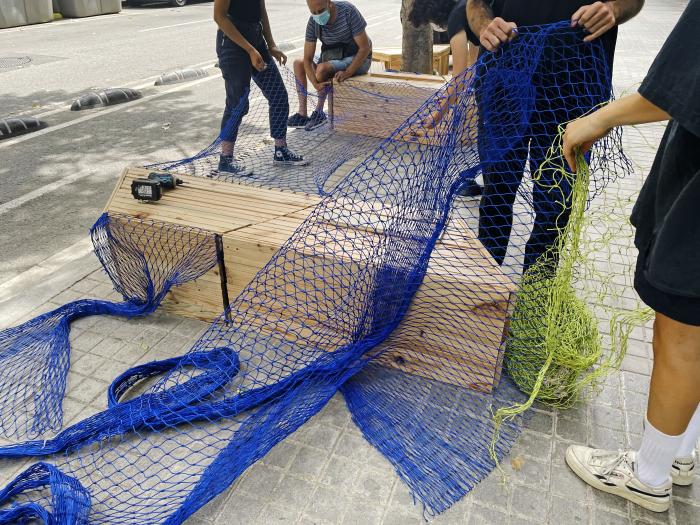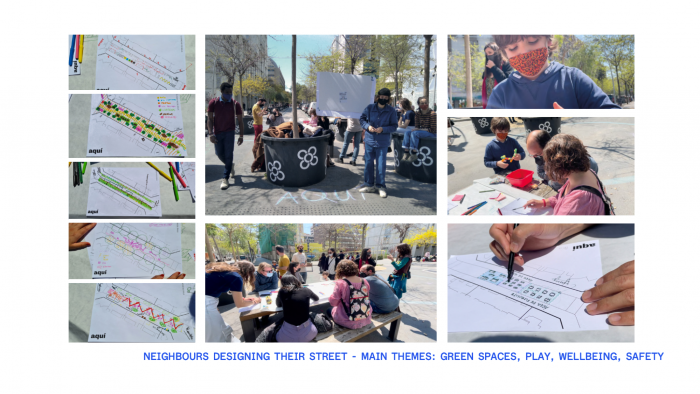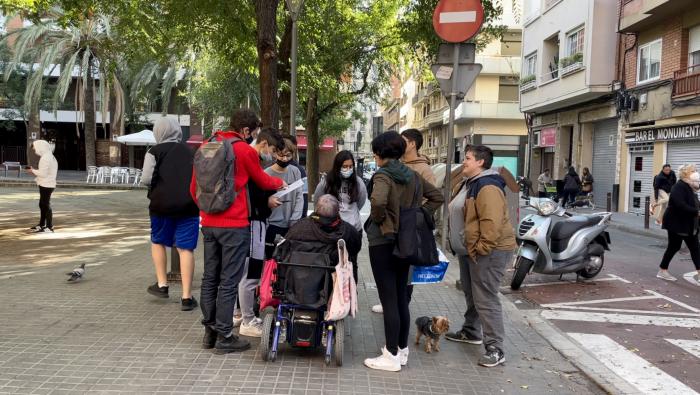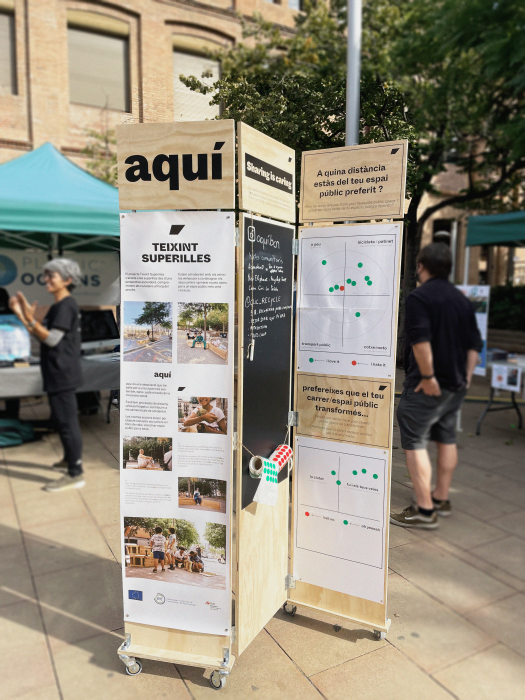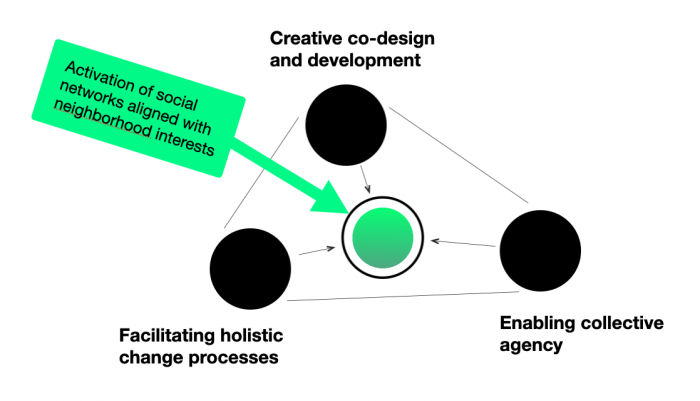Within this context of environmental emergency and global health crisis, aquí proposes to weave social fabric and cultivate co-responsibility through co-creation urban design methods that are scalable to other cities and communities. When citizens have the opportunity to participate in placemaking activities, they gain not only greater awareness of their environment, but also a sense of agency that fosters more ecological, just and inclusive communities.
- European Institute of Innovation &Technology Cross-KIC New European Bauhaus - Call for Proposals for Citizen Engagement, 2021
- Resistiré - Green Spaces Pilot Project, 2022 ( funding from the EU Horizon2020 research and innovation programme under grant agreement no. 101015990)
aquí develops and practises co-creation methods for social innovation towards ecological, just and inclusive communities. aquí seeks not just to provide solutions in the form of physical and social urban interventions, but to develop tools, skills and collective capacity for transformation. Designing for an inclusive, equitable and sustainable world means building capacity within the community. aquí engages citizens to reimagine, co-create and regenerate public spaces. Our main expertise lies in designing and facilitating participatory processes taking an intersectional approach.
For instance, in conversation with Barcelona City Council and the local neighbours’ association, aquí led a participatory design process for Sancho de Ávila street in the neighbourhood of Poblenou, Barcelona. The project involved several ideation and co-creation workshops and the design and collective construction of modular urban furniture made of recycled materials together with the neighbours as a prototype for the pacified street. To ensure the replicability of the project, we distributed an open-source building manual for the urban furniture modules.
Through our Teixint Superilles project, funded by the European Institute of Innovation and Technology (EIT), we continued to grow aquí’s practice. Through a series of co-creation workshops, aquí experimented with methodologies for civic participation with a focus on gender, functional diversity, inter-generational inclusion and sustainable mobility. We created spaces of exchange where people could share their lived experiences, perspectives, and build dialogue around the city’s new urban model.
Please highlight how the concept/idea can be exemplary in this context
aquí systematically selects natural and/or upcycled materials (e.g. local wood, fishing nets, natural inks) for our designs. Yet, our commitment to sustainability goes much further than material choices. The process of aquí builds a new foundation for urban solutions to sustain, adapt and regenerate. Circularity and sustainability are strongly linked to community awareness, agency and resilience. The more people bond with the community and the places they share, the more they will care for the environment they inhabit.
Barcelona is among the most densely populated cities in Europe, and suffers from major environmental and social challenges such as air and noise pollution, lack of access to green spaces and spatial inequalities. Some recent examples of how aquí has been tackling these environmental challenges include co-designing a chameleon-shaped air-quality sensor with children, facilitating a bike-lane design workshop with a local collective, researching pedestrian mobility and infrastructure, or contributing to weaving an ecosystem of care in a public park.
Aiming to generate long term sustainable behaviour change , aquí seeks not to just provide a shape of a new solution, but the tools, skills and organisational capacity for transformation. Cities have to embrace change, continuously adapt to it and take responsibility for building sustainable and circular futures. Within this context, aquí leverages our design practice as a tool for social transformation and environmental regeneration.
Please highlight how the concept/idea can be exemplary in this context
As you will note in the attached pictures, the aesthetics of aquí’s projects reflects our values: inclusion, creativity, collective agency and planetary well-being. The beauty of our physical urban interventions lies in their creative process: aquí focuses on the social innovation process and co-design experience rather than the final form of the product. Above all, we value the experience of our participants and the sense of belonging we generate with our projects.
Through facilitating co-creation, including participatory and co-design processes, we want to nurture a sense of responsibility towards the urban environment and others who inhabit the shared space. Co-creative processes empower people to take better care of the spaces they inhabit, and since they promote inclusion of diverse perspectives, the end result of these processes are more welcoming for all. aquí co-creation processes seek to include vulnerable groups, in order to nurture more respect and mutual care among users of public spaces, bridging interests and finding solutions to conflict.
aquí wants to serve communities across Europe by sharing replicable guidelines for co-creation methods for social innovation. We are confident such processes of co-designing public spaces can only contribute to benefitting users and policymakers alike. We always openly share our design process and its documentation. For the project in Sancho de Ávila, in Barcelona’s neighbourhood of Poblenou, we documented and distributed an open-source manual for the construction of urban furniture (providing instructions for replicability) through the project website and our social media. For Teixint Superilles we elaborated an openly available manual that documented the whole participatory process, and was shared with the European Institute of Innovation and Technology (EIT) Urban Mobility to be replicated at European level.
Please highlight how the concept/idea can be exemplary in this context
At aquí , we consider that in order to build a more inclusive future, we have to encourage dialogue across cultures, disciplines, genders and ages. Inclusion for us encompasses valuing diversity, building strong and resilient communities, securing accessibility, affordability and upholding the right to the city for all. Our concept aims at spatializing inclusion through co-creation and social innovation. We consider citizen engagement and participation methodologies for co-creation are invaluable for the cultivation of inclusion in our communities at the local level.
When citizens have the opportunity to participate in design and placemaking activities, they gain not only greater awareness of their environment, but also gain a sense of agency and responsibility. The impacts of placemaking and co-creation are both tangible and intangible. We believe our workshops, activities and processes open spaces that are crucial for our communities. These spaces are necessary for people to meet, to dialogue, to confront their differences, and learn to value diversity.. To face the challenges of the future, we need strong and resilient communities. At aquí we believe co-creation processes will make us discover the richness of our diversity and build more inclusive cities.
In our latest project, we worked with teenagers from a public school in the neighbourhood of Sants in Barcelona. The class was composed of a diverse group of students from diferent social classes, origins, with multiple languages being spoken. Through a series of workshops and mobilising co-creation methodologies, we engaged the students to work with the concepts of gender, functional diversity and intergenerational design. By exploring these concepts in class and in the public space, we were able to cultivate a more inclusive view of their environment.
Please highlight how this approach can be exemplary
aquí’s concept of co-creation methods for social innovation aims at building more ecological, just and inclusive communities. aquí’s co-creation processes and civic engagement methodologies can lead to social or physical interventions. The recent pandemic has shown that while conventional approaches addressing the environmental emergency continue to fail, large scale societal change can happen rapidly. aquí views design as a tool for social transformation and environmental regeneration, a tool that allows for replicability and that can be scaled in other cities in Europe and the world.
Against the polarisation and alienation of our communities, we strive to build dialogue and cultivate mutual understanding between citizens. Applying co-creation methods opens spaces for conflict resolution and meditation within communities. Thus, we cultivate inclusion by fostering social dialogue through methods such as design workshops, exploratory walks or collective construction methods. For instance, in our workshops we have managed to promote dialogue between elderly people with functional diversity and young students.
We understand co-creation as processes that include relevant and diverse knowledge in urban processes to find innovative solutions to complex problems. These processes are founded on transdisciplinary approaches, and in particular we have been applying a gender+ and intersectional perspective. The cornerstone of our work is civic engagement and revitalising social connections through both social and physical interventions, for us, the necessary catalyst for building a community of care.
We consider people’s sense of belonging is dependent not only on the quality and aesthetics of physical places, but also on the density of social networks between neighbours and levels of inclusion.
We consider our concept innovative because its impact is cumulative and scalable for other European countries. aquí processes of co-creation allow for inclusive and intersectional dialogues between people, fighting alienation and cultivating empathy. These processes also contribute to weaving the social fabric of communities, neighbours and the city at large, which are a necessary condition for building resilient cities and more inclusive futures. From creative community engagement strategies to participatory processes of emotional and conflict mapping, diverse groups are invited and encouraged to listen to each other and understand each others’ perspectives, in order to improve quality of life for all.
We recall how in one street workshop, an elderly man expressed strong criticism against reducing car lanes in a street. By the end, he had changed his mind since he had whole-heartedly listened to a nine-year old boy’s vision from next door. The boy was able to communicate his more sustainable vision for his street.
The innovative character of our concept also lies in our approach to co-creation methods as a tool for conflict resolution within communities. aquí wants to unfold the creative, passionate, strategic, connected and innovative potential of communities and leave no one behind. We have particularly worked to adopt an intersectional approach that seeks to include women and gender non-binary people, children, youth and elderly people, people from migrant backgrounds, and people with functional diversity.
Finally, in aquí we believe in diversity as fuel for innovation. We embody such diversity in our passionate team from Spain, Germany and France, with backgrounds that range from product and urban design, governance and conflict resolution, to urban research and design innovation. We work with the aim to spread our concept across borders by developing a global network of practice, who value diversity, creativity, and innovation.
At the moment aquí has two ongoing projects that are going to help explore and develop our concept further.
aquí has been selected as one of the two pilot projects of the European project Resistiré for creating ecosystems of care in green spaces. The pilot aims to investigate how green spaces can become ecosystems of care by implementing a cultural programming focused on inclusion and gender perspective. This pilot aims for a social transformation, rather than a physical one. We are very interested in exploring how synergies and articulation with civil society organisations can make public space more inclusive and qualitative for all.
In addition, we were recently commissioned by the Barcelona City Council to design an artistic intervention in the public space. Our aim will be to intervene in an abandoned space that used to be a large parking lot in front of the coast. First, we want to reclaim spaces designed for cars that will be part of the future major transformations that put people at the centre. Secondly, we want to design a physical intervention that can act as a bridge between the intensive car-use parking lot, and the future green space that the city council is planning.
We are also constantly improving our communication strategies. We believe that knowledge needs to be accessible, ensuring we communicate our approach and concepts clearly is a pillar of our work. We wish to develop a global community of practice. We are looking forward to extending our partnerships across Europe and to create an international network of actors with a common goal to activate social connections that create more meaningful and healthier relationships among people and the environment.
If aquí were awarded the New European Bauhaus prize 2022, we would like to use the resources to develop a network of partners across Europe. We would work on establishing and cultivating a social innovation ecosystem in Europe, connecting actors in different regions. We would facilitate a space for dialogue, creative exchange of best practices, and generating synergies to tackle social challenges together. The outcomes would be a series of open co-creation workshops, a web platform, and potentially other creative formats to stimulate collaboration. With this initiative we hope to generate lasting change at three levels: build momentum behind social innovation throughout Europe, share innovative methodologies to the public and private sectors, and unite forces to combat social inequalities. We seek to integrate the practices of collaborative design, citizen participation and open-source solutions to achieve the sustainable development goals. One example to start developing this network would be to plan an action research visit to Graz, Austria, where the other pilot project creating ecosystems of care in green spaces from the Resistiré European project is being implemented, to exchange experiences, give mutual feedback on our respective local ecosystems, and tackle challenges together.
In addition, we would launch a concerted effort to give back to our local network of partners: local schools, community centres, collective gardens, makerspaces, neighbours associations, etc. We would freely contribute our skills and expertise to support their mission of serving the community in diverse and unique ways.
@Lozano Carbassé, 2022
Content licensed to the European Union.
